|
The Wagner Daily ETF Report For November 4
Trading in a narrow, sideways range before closing with mixed results, the major indices kicked off the month with a session of healthy price consolidation. The Nasdaq Composite advanced 0.3%, as the S&P 500 declined by the same percentage. The Dow Jones Industrial Average was lower by just 0.1%. The small-cap Russell 2000 gained 0.3% and the S&P Midcap 400 was unchanged. Oscillating in an intraday range of less than 2%, the S&P 500 refreshingly traded in its tightest range in more than a month. Each of the main stock market indexes closed at, or just below, the middle of its intraday range.
Turnover fell sharply yesterday, but that's a good thing when stocks are consolidating their recent gains. Total volume in the NYSE was 23% lower than the previous day's level, while volume in the Nasdaq declined 25%. As we mentioned yesterday, lighter volume on "up" days is negative because it shows a lack of institutional buying support. However, lower volume on sideways days of price consolidation is bullish, as it indicates the bulls are merely taking a break, and the bears are not stepping in to sell into strength. In both the NYSE and Nasdaq, advancing volume was roughly on par with declining volume.
In yesterday's Wagner Daily, we looked at the short-term resistance levels in the broad market. Specifically, we said traders would be focused on whether or not the S&P 500 and Nasdaq Composite would be able to break out above their 20-day exponential moving averages (EMAs). With yesterday's nearly unchanged closing prices, the situation remains the same going into today's session. Presently, the S&P 500 is just three points (0.3%,) and the Nasdaq Composite only six points (also 0.3%), below its 20-day EMA. Since stocks had a tight session of consolidation yesterday, the major indices now have greater odds of breaking out above their 20-day EMAs.
Although the major indices were little changed yesterday, several industry sectors showed relative strength by registering solid gains. With the broad market in a situation that could easily lead to another leg higher in the short-term, it's important to know which ETFs may offer the best momentum-trading opportunities for further upside. In this regard, there are two types of potential trade setups we're looking at: breakouts above tight, short-term areas of consolidation, and pullbacks to support of ETFs that have been trending strongly off their lows. First, we'll take a look at a few charts of ETFs poised to break out above their short-term consolidations:
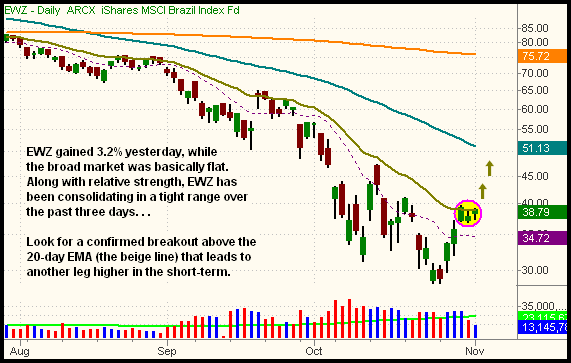
Over the past three days, iShares Brazil (EWZ) has been consolidating in a tight range, right at its 20-day EMA. Yesterday, EWZ showed relative strength to the broad market by gaining 3.2% while the domestic markets were basically flat. Today, watch for EWZ to gap up above its three-day range and start to make another leg up in the short-term. Per Intraday Trade Alert to subscribers, we already bought EWZ yesterday, as it popped above the previous day's high. As with practically every other ETF setup right now, we are not looking for a new primary uptrend to develop at this point. Rather, we're playing the momentum of an anticipated counter-trend bounce. Our approximate price target is resistance of its 50-day MA (the $51 area). Two related plays with similar chart patterns are iShares Latin America (ILF) and Vanguard Emerging Markets (VWO).
Another ETF positioned to break out above its short-term consolidation is the tracking stock of the tech-heavy Nasdaq 100 Index (QQQQ):
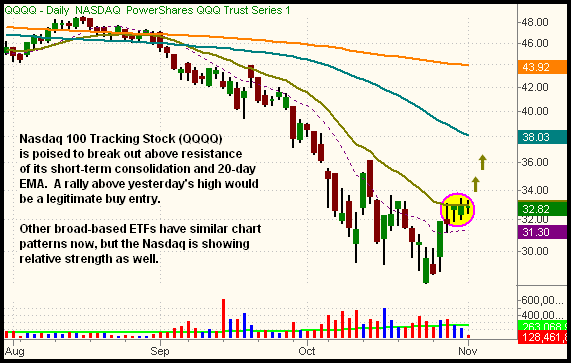
As you can see, the 20-day EMA of QQQQ has been like a magnet over the past four days. A rally above that 20-day EMA, as well as the high of the past four days, should generate a decent amount of upside momentum, at least in the short-term (2 to 5 days). Another thing we like about QQQQ is that it pulled back to kiss support of its 20-EMA/60 min. yesterday. This is highlighted on the hourly chart below:
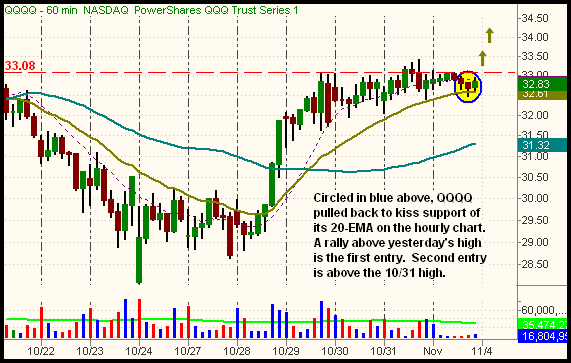
If QQQQ breaks out, a realistic price target is, again, the 50-day MA (around $38). To protect against a failed breakout in the broad market, consider keeping a tight stop just below the 20-day EMA, which should become new support after the breakout. Traders looking for more "bang for the buck" might consider buying Ultra QQQQ ProShares (QLD); it follows the Nasdaq 100 Index, but is leveraged to move at double the price percentage of the underlying index. As one might surmise, the chart patterns of the S&P 500 and Dow Jones Industrial Average ETFs are similar to QQQQ. However, the Nasdaq has been showing more relative strength than the other two indices.
The next ETF on our watchlist of potential short-term breakouts is Vanguard Utilities (VPU):
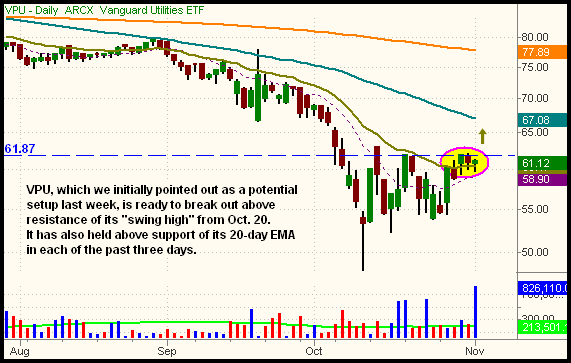
As you may recall, we initially pointed out the relative strength of this ETF last week, but it has not yet triggered for long entry. Now, with three days of tight consolidation above its 20-day EMA, the setup is more likely to follow-through to the upside. Again, the buy trigger is above the high of the past three days, but beware that resistance of the 50-day MA is not very far above. Select Utilities SPDR (XLU) is another ETF in the same sector that bears a similar chart pattern. Next, we'll move on to a few ETFs that have zoomed off their lows and we're watching for a pullback.
Yesterday, the top-gaining ETF in our world of more than 300 ETFs we follow was Claymore Global Solar Energy (TAN), which rocketed a whopping 17.8% higher! Volume also swelled to nearly three times its average daily level, indicating the presence of institutional accumulation. Take a look:
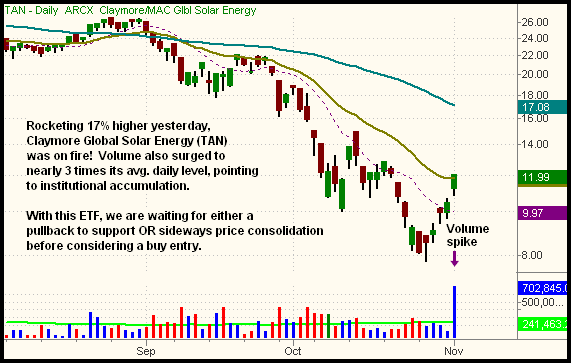
With such a massive move, a breakout above the 20-day EMA, and strong volume, TAN is definitely seeing a lot of buying interest. However, because it has already rallied approximately 50%(!) in just five days, there is not a good reward/risk ratio to buying at current levels. Instead, wait for either a correction by price (pullback) or correction by price (consolidation). If TAN pulls back, a touch of the 20-EMA/60 min. (around $10.70) would be an ideal buy entry. If buying interest in solar energy remains quite strong, TAN may simply consolidate (correct by price), rather than pulling back. Ideally, we'd like to see a tight, sideways consolidation for at least three to four days. A subsequent breakout above the high of that consolidation would be buyable for a momentum trade.
Not as strong as yesterday's solar energy performance, but showing relative strength nonetheless, is the biotech sector. Yesterday, Biotech HOLDR (BBH) rallied 2.5% and iShares Nasdaq Biotech gained 2.1%. Both ETFs broke out above resistance of their consolidations, and are now buyable on a slight pullback to near their breakout levels. Below is the daily chart of BBH:
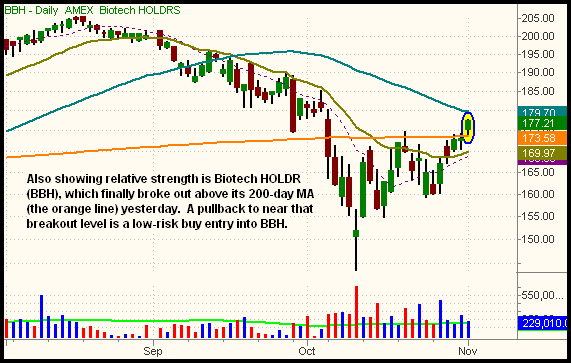
The thing we really like about BBH is that it just broke out above key resistance of its 200-day moving average. Conversely, a vast majority of ETFs are still well below their 200-day MAs. Notice how the 200-day MA of BBH acted perfectly as resistance several times last month. As such, it should now act as major support on a pullback. Therefore, as you might have guessed, a slight pullback to near its 200-day MA, currently at $173.58, presents an ideal buy entry. Support of the 20-EMA/60 min. (not shown on the daily chart) is just above $174.
Finally, as a possible hedge against any bullish positions, you might consider buying CurrencyShares Japanese Yen (FXY) on a rally above yesterday's high:
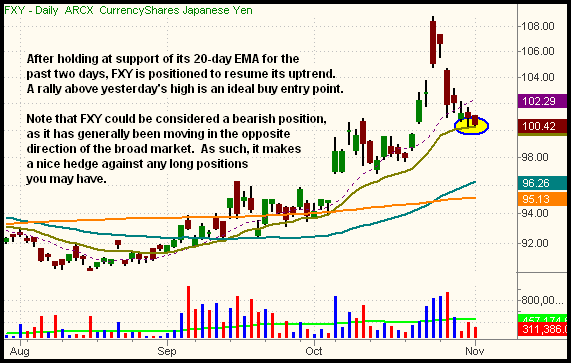
Sitting perfectly at support of its 20-day EMA for the past two days, after pulling back from its all-time high, FXY will move back above its 20-EMA/60 min. if it rallies above yesterday's high. FXY is considered a hedge against long positions because it has generally showed strength when the broad market is weak. It is definitely not a bad idea to include a bearish position among any long positions you may buy in the coming days.
Open ETF positions:
Long - EWZ, DGP
Short - (none)
Deron Wagner is the Founder and Head Trader of both Morpheus Capital LP, a U.S. hedge fund, and Morpheus Trading Group, a trader education firm launched in 2001 that provides daily technical analysis of the leading ETFs and stocks. For a free trial to the full version of The Wagner Daily or to learn about Wagner's other services, visit MorpheusTrading.com or send an e-mail to deron@morpheustrading.com.
|